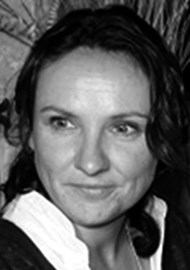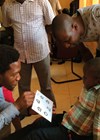In sub-Saharan Africa 19.4 million people have diabetes; this is projected to rise to 28.6 million by 2030 [1]. Sight loss from diabetes devastates the lives of working people, affecting the financial stability of the families and communities who depend on them. In high-resource environments, comprehensive eye screening programmes for people with diabetes have led to reduced rates of blindness from diabetic retinopathy (DR).
In low- and middle-income countries (LMICs) the task for policymakers is to implement screening and treatment services that are both effective and cost-effective, well-integrated into the existing healthcare system and which strengthen existing eye care programmes. Sharing lessons learned in the strategic development of diabetic eye care programmes may help countries facing similar challenges.
Diabetes and DR in Malawi
Malawi has a population of 19.1 million and an adult prevalence of diabetes of approximately 2% and 3% in rural and urban areas, respectively [2]. It is estimated that over 150,000 Malawians have DR and around 45,000 have vision-threatening disease. There is a high prevalence of sight-threatening DR in persons attending diabetes clinics [3,4,5].
The health system in Malawi
Health services in Malawi are provided by public, private for-profit and not-for-profit sectors (the latter including religious organisations and Non-governmental organisations (NGOs). The health system is organised at four levels. At community level, services are delivered by health surveillance assistants, health posts, dispensaries and maternity clinics. Primary level facilities include health centres (providing out-patient and maternity services for up to 10,000 people) and community hospitals (up to 250 beds). Secondary level consists of 28 district hospitals and Christian Association of Malawi (CHAM) hospitals of similar size. At the tertiary level, four public central hospitals (in Lilongwe, Blantyre, Mzuzu and Zomba) would ideally provide specialist care and referral services to surrounding districts, though in practice high levels of local demand mean that around two-thirds of services they provide are primary or secondary.

Photo 1: Patient engagement session facilitated by Malawian social scientists.
Strategic workshop
A five-day strategic workshop was held at the Malawi-Liverpool-Wellcome Trust Clinical Research Programme (MLW), Blantyre, in 2018. The event was funded by a Global Challenges Research Fund Networking Grant (Ref: GCRFNG100473). The aim was to plan a programme of funded service development and health services research to develop and evaluate locally-appropriate, sustainable models of care to prevent blindness from diabetes in the whole of Malawi. Policymakers from the Government of Malawi Ministry of Health (MoH), ophthalmologists from Malawi and the UK, diabetologists from Malawi, social scientists and NGO representatives participated in the workshop.
Current DR service provision
DR screening and treatment is recognised by the Prevention of Blindness Committee as part of the WHO package of essential non-communicable disease (NCD) interventions (PEN) [6]. Screening and referral systems operate at central hospitals in Blantyre and Lilongwe along a model developed by the Lilongwe-Fife LINK [7] partnership comprising:
- direct ophthalmoscopy by ophthalmic clinical officers (OCOs) to detect disease
- referral of proliferative DR to central hospitals for treatment
- transport by existing government district hospital system (secondary to tertiary)
- paper-based record keeping; referral by paper notes carried by all patients in the Malawian health system (the ‘patient passport’)
Current strengths include: a cadre of largely well-motivated and skilled OCOs; ophthalmologists in all four central hospitals, with lasers in three; a training pipeline of ophthalmologists and a strong patient group (Box 1). Weaknesses are: direct ophthalmoscopy only; lack of photography for quality assurance; activity restricted to central hospitals and some nearby district hospitals.
Diabetic Retinopathy Care Pathway
In 2018 Malawi had 11 ophthalmologists working mainly in central hospitals. A large proportion of ophthalmic care at tertiary and secondary level is provided by OCOs (who have completed three years general training plus an 18-month diploma in ophthalmology) and optometrists.
DR services have been developed in Malawi following the country-wide VISION 2020 LINKS Programme Action Plan (developed in Durban, 2016) [8] with many notable successes:
- provision of a laser and appointment of an ophthalmologist in Mzuzu
- appointment of two DR programme managers (Lilongwe, Blantyre)
- training of substantial numbers of OCOs in recognition and referral of DR
- ophthalmologists represented on the national NCD Committee.
Key challenges and aspirations considered during the workshop
Delivery of diabetes care in Malawi
Diabetes care is delivered principally from central and district hospitals with little active prevention, screening / diagnosis or outreach care. Pathways differ for district hospitals that are close to a central hospital, because of transport costs and impact of loss of earnings.
Services are almost entirely absent at health centre and community level. Inadequate funding leads to a lack of human resources, clinical equipment, clinical tests (including HbA1c), drug supplies and transportation. Retention of trained staff and a lack of referral pathways (including discharge to secondary and primary care) are particular problems. Patients emphasised concerns about length of clinic visits, transport, clinic environment and facilities, staff training and drug supplies.
Aspirations to improve diabetes care
Malawian diabetologists expressed the aspiration for integrated and decentralised services with strong monitoring and evaluation with a public health approach, similar to effective HIV care delivery. NCD programmes are receiving increasing priority from the MoH. Renewal of diabetes services in Southern Malawi has recently been funded by the World Diabetes Foundation (WDF), to be delivered with the NGO Partners in Health. Capacity-building in health services research is being achieved through initiatives including ‘NCD BRITE’ [9]. Integration of diabetes into HIV and TB programmes is a possibility.
Clinical data accessibility and management is very limited as numbers of patients attending diabetes and NCD clinics increase. Malawi uses a paper-based records system (‘Mastercard’). Electronic patient record systems have faced challenges. Community awareness programmes are seen as an important mechanism for reducing morbidity and mortality from diabetes but would require the MoH to pay community workers.
Challenges in meeting patient needs through DR services
Epidemiological data on diabetes and DR is urgently required as the only Rapid Assessment of Avoidable Blindness (RAAB) was undertaken 10 years ago (in the South-West). Patients expressed the need for education on diabetes complications and accessibility of examinations for complications and comorbidities.
Key challenges expressed by Malawian ophthalmologists were the lack of human resources and equipment and ophthalmologists trained to deliver laser treatment. There is a need for further training of OCOs. More lasers (with service agreements) are required. Infrastructure for intravitreal anti-VEGF treatment in the public sector is limited to the central hospitals in Lilongwe and Blantyre. There are few fundus cameras with which to develop a digital screening system. Coverage of district hospitals and quality assurance of the screening test are considered pressing barriers. The need was expressed for a point-of-care screening test for DR which can be delivered by mid-level health workers (OCOs). Collection of accurate clinical data is also a key challenge. National screening and treatment guidelines are required (and are now in development).
Workshop outputs
Two parallel complementary approaches were identified:
- A core model for delivery of DR services that is sustainable and locally relevant
- A programme of research to address key gaps in knowledge.
1. DR screening and treatment programme
A model and timeline for the introduction of DR services was developed. Key features of the plan are:
- a locally appropriate, sustainable model of care
- training of diabetes and eyecare professionals
- development of screening and treatment infrastructure
- activities to increase community awareness of the threat of diabetes to eye health.
In Phase 1, four central hospitals (Blantyre, Lilongwe, Zomba and Mzuzu) will enhance their existing screening and treatment programmes. Point-of-care screening embedded in diabetes / NCD clinics will be delivered through digital photography. Image grading will be done by OCOs supported by artificial intelligence (AI) systems. Paper-based patient records will transition to an electronic data collection system supporting a call / recall system. Laser training will continue to be delivered as part of postgraduate ophthalmology training in Malawi (MMed programme). Patient-friendly treatment protocols will be developed to help reduce the number of hospital visits required.
Phase 1 activities in ‘near’ district hospitals will include replication of central hospital screening activities and additional training of OCOs. In phase 2, screening activities will be delivered in ‘far’ district hospitals. A telemedicine system to support OCO grading will be developed. A community awareness programme will be initiated, to improve early detection and intervention for diabetes complications.
To deliver the model, funding will be required for equipment (two lasers and six fundus cameras), training (laser training for MMed ophthalmologists using an observational skill-based clinical assessment tool; training the trainers courses; further training for OCOs in screening and referral), and electronic data collection systems including a call/recall system. Strengthening of the existing hospital transport service will be required. National screening and treatment guidelines will be developed. A reading centre will facilitate quality assurance of grading. Availability of anti-VEGF medication will provide an alternative to laser treatment for some patients. NGO funding will be sought for set-up costs, with MoH approval, to ensure a sustainable model.
2. Research programme
A programme of mixed-methods, health systems strengthening research and evaluation was outlined, applying social science methods to meet the needs of the local population and using cutting-edge technology to embed quality assurance, reduce the cost, improve case selection and introduce point-of-care diagnosis.
A strong, funded research partnership to focus on diabetes and sight loss will be developed between all stakeholders, supported by NGOs and UK academics, highlighting efficacy and cost-effectiveness and including all central and district hospitals.
The research programme will have four key work packages focusing on:
- evaluation of the DR screening and treatment programme
- understanding community-level issues: awareness of diabetes and eye health; barriers to accessing care; impact of location and gender
- epidemiology of DR, coverage of services and economic impact of blindness
- assessment of technological advances, including efficacy and acceptability to patients.
Conclusions
Traditionally, health systems in LMICs have focused on delivery of care for acute episodes for example, childbirth, infectious diseases and trauma. Diabetes and its complications are particularly challenging as multidisciplinary care is required across a lifetime. Access to a broad range of services is necessary to achieve optimum health outcomes. Communication between care providers and pathways allowing referral to specialist services and discharge to local care are required.
A model of care to detect and manage DR must be locally appropriate, effective, cost-effective, sustainable and acceptable to both patients and health workers. Critically, introduction and development of DR services should strengthen existing eye health systems. In Malawi there is an opportunity to develop DR services through a partnership between Malawian policymakers, diabetologists, ophthalmologists, social scientists and patients, supported by international NGOs and academics. A parallel research programme will be key to ensure continued improvement in care delivery and optimum resource use. Models of care developed here will be relevant to low-resource settings globally.
BOX 1 : DIABETES ASSOCIATION OF MALAWI
-
Formed in 2007 by people with diabetes attending Queen Elizabeth Central Hospital (QECH) Blantyre in response to challenges faced by patients in respect to provision of treatment and availability of medications.
-
Joined the International Diabetes Federation in 2011.
-
Mission – to educate people with diabetes regarding management of the disease and its complications; sensitise the general public of Malawi to diabetes; advocacy to government and other health service providers for diabetes care services. Majority of patients attending diabetes clinics are members.
References
1. Saeedi P, Petersohn I, Salpea P, et al. IDF Diabetes Atlas Committee. Global and regional diabetes prevalence estimates for 2019 and projections for 2030 and 2045: Results from the International Diabetes Federation Diabetes Atlas, 9th edition. Diabetes Res Clin Pract 2019;157:107843.
2. Price AJ, Crampin AC, Amberbir A, et al. Prevalence of obesity, hypertension, and diabetes, and cascade of care in sub-Saharan Africa: a cross-sectional, population-based study in rural and urban Malawi. Lancet Diabetes Endocrinol 2018;6(3):208-22.
3. Burgess PI, Allain TJ, García-Fiñana M, et al. High prevalence of sight threatening retinopathy and visual impairment due to diabetes in Malawi; identification of population specific targets for intervention. Diabetic Medicine 2014;31(12):1643-50.
4. Burgess PI, Harding SP, García-Fiñana M, et al. First Prospective Cohort Study of Diabetic Retinopathy from Sub-Saharan Africa: High Incidence and Progression of Retinopathy and Relationship to Human Immunodeficiency Virus Infection. Ophthalmology 2016;123(9):1919-25.
5. Burgess PI, Harding SP, García-Fiñana M, et al. Incidence and progression of diabetic retinopathy in Sub-Saharan Africa: a five year cohort study. PLOS ONE 2017;12(8):e0181359.
6. WHO Package of Essential Non-Communicable (PEN) Disease Interventions for Primary Health Care:
https://www.who.int/publications/i/
item/who-package-of-essential-noncommunicable
-(pen)-disease-interventions-for-primary-health-care
(Last accessed February 2022).
7. Annoh R, Msosa J, Styles C, et al. Building capacity for diabetic retinopathy services in Malawi. Eye News 2019;26(2):28-34.
8. Astbury N, Burgess P, Foster A, et al. Tackling diabetic retinopathy globally through the VISION 2020 LINKS Diabetic Retinopathy Network. Eye News 2017;23(5):30-34.
9. van Oosterhout JJ, Hosseinipour M, Muula AS, et al. The Malawi NCD BRITE Consortium: Building Research Capacity, Implementation, and Translation Expertise for Noncommunicable Diseases. Glob Heart 2019;14(2):149-54.
COMMENTS ARE WELCOME


















